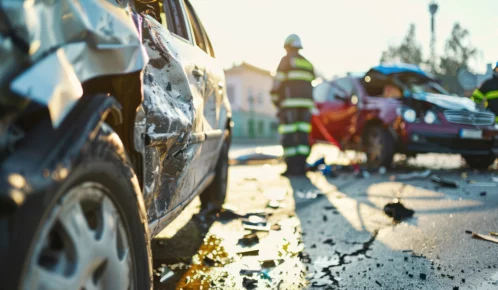Passengers may be wondering, “is the back seat safer than the front?” According to the Insurance Institute for Highway Safety (IIHS), many back seat passengers assume they are safer in the back seat, so they don’t buckle their seatbelts. In a car crash, backseat passengers who aren’t wearing seat belts can sustain serious injuries and cause injuries to front seat passengers.
Table of Contents

The Back Seat is not as Safe as it Seems
Only about 72 percent of people buckle up in the back seat, compared to 91 percent in the front seat. In adults from ages 35 to 55, only 66 percent regularly buckle up. Four out of five adults who use taxis, Uber or Lyft rides, rental cars, and other types of private transportation services never bother to buckle their seatbelts. When asked why, most respond they are only traveling a short distance, or that rear seat belts are awkward to buckle and uncomfortable to wear.
Car Crashes Without Seatbelts Are Dangerous for Back Seat Passengers
There is a common misconception that people are safer in the back seat, but the truth is that rear seat passengers who are not buckled up are more likely to die in a crash. Upon impact, they are often thrown forward into the back of front seats with significant force. This forces airbags to deploy while throwing the driver into the steering column and front seat passengers into the dashboard or windshield. According to IIHS data, 1,018 unbuckled back seat passengers died in 2015 car accidents. Data shows that unbuckled rear seat passengers face an eight times higher risk of injury or death in a crash than rear seat passengers who are buckled up.
The National Highway Traffic and Safety Administration (NHTSA) has warned drivers about seat belt safety for decades. As a result of years of seat belt safety awareness ads and campaigns, most drivers and front seat passengers now buckle up, but back seat passengers do not. Although the 1997 death of Princess Diana put a national spotlight on the need to buckle up in the back seat, a large percentage of rear seat passengers still don’t use seat belts. Unfortunately, in a car crash, the laws of physics still apply for back seat passengers and create significant risks for injuries and fatalities.
Stricter Seatbelt Laws
NHTSA research suggests that stricter state seat belt laws could reduce the number of traffic deaths by as much as 17 percent. In 2013, more than half back seat passengers killed in car crashes were not wearing seatbelts, but only 28 states required back seat passengers to buckle up. Currently, 34 states have seat belt laws that allow law enforcement to ticket a driver and front seat passengers who are not wearing seatbelts, but only 18 states have the same laws for back seat passengers.
Seat belt reminder systems became mandatory in the 1970s. Most newer model cars have annoying pinging sounds and flashing lights that remind front seat passengers to buckle up, but only seven percent of 2018 car models have rear seat belt reminders. Rear seat passengers who are not buckled up can sustain serious injuries in a car accident, even if the car is traveling at a slow speed. Hospital emergency rooms often see serious head trauma, skull fractures, neck and chest injuries, facial lacerations, and broken limbs caused when a passenger in the back seat of a car is jolted into the front seat, dashboard, or windshield.
In 2015, there were two high-profile crash deaths to backseat passengers who were not buckled up. Bob Simon, a well-known 60 Minutes correspondent, died in a taxi crash in Manhattan. When thrown out of the backseat on impact, he suffered severe head trauma and a broken neck. John Forbes Nash Jr., the Princeton University mathematician that inspired the film A Beautiful Mind, died when he was thrown from the backseat in a New Jersey car crash. Neither Bob Simon, age 73, or John Forbes Nash Jr., age 86, were wearing seatbelts. According to studies, adults age 55 and overriding in the back seat of a car are more likely to suffer life-threatening injuries or death in a crash, even if they are properly buckled in.
Traffic safety experts and organizations promote stricter seat belt laws for rear occupants. It’s not that the back seat has become more dangerous, it’s that the front seat has become safer. Design improvements to shoulder belts, front and side airbags, and seatbelt reminder systems promote front seat safety but leave back seat passengers unprotected. While some newer car models do have side rear airbags, they are typically expensive add-on purchases for a car buyer. Drivers often turn them down to save money or to purchase other extras, such specialized music systems, heated seats, and automatic door locks.



